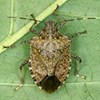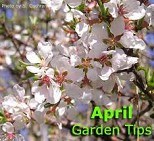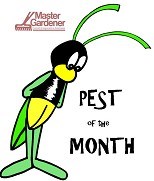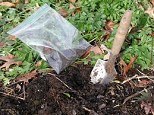Do you have some unwelcome visitors in your home that you don't recognize? It may be the Brown Marmorated Stink Bug (BMSB), Halyomorpha halys (Stål). Over the past 10 years it has spread from New Jersy where it was first sited to many midwestern states. According to Organic Gardening: "Once inside, stinkbugs don't eat anything, and they don't bite."
Posted 4/26/2017

Posted 4/26/2017
This is still a good time to prune your deciduous shrubs (those that drop their leaves in the fall). When the leaves are gone, it easy to see and reach interior branches which need to be removed. Pruning requirements vary by plant, but in general, all plants will benefit from the following:
- Use clean, sharpened pruners and lopers.
- Remove all dead and damaged branches.
- Remove branches which cross through the middle of the plant.
- Remove branches which rub against other limbs.
Posted 4/25/2017

Nothing says spring like these beautiful early spring flowers
BELMONT, N.Y. — Did you get spring plants for Easter? Well you may be lucky enough to get more for Mother’s Day; so what do you do with them all? First, check the tag with the plant, which will give you some basic information and then read below for more details. Remember, you can plant them in your garden and enjoy them again next year!
Posted 1/26/2017
Did you know New York State is over 60% forested and that 85% of these forests are owned by private landowners? Most forest landowners are not aware of the range of options available in planning for their woodland’s sustainable future.
You and Your Forest, is a FREE informational letter series that can help you begin the process of good forest stewardship without leaving the comfort of your home. The letter series does not require any previous knowledge of forests or forestry. If you sign up, you will receive seven, 8-page, self-study installments beginning in late winter and sent every two weeks through spring, by either email or regular mail.
Issue topics include forest ecology, protecting your forest assets, agroforestry practices (mushrooms, ginseng…), enhancing your forest for wildlife, forest management, forest invasive species and much more. So, whether you own 5 acres or 500, now is the time learn how to be a good forest steward. For more information contact Cornell Cooperative Extension of Columbia & Greene Counties at 518-622-9820.
Deadline to register is February 23, 2017.
Posted 7/13/2016 by MG

There is some good and some bad to report. The good is that things are growing fast. The tomatoes have lots of flowers and small fruit. The squash is full of flowers, buds, and baby squash. Best of all, watering is not as big a problem as we thought it might be. The bales are breaking down inside and seem to be holding water well. No need to water every day right now.
The bad news is that some heavy rain knocked the potatoes down and they are now hanging down in front of the bale. (Front right of bales). Looks like hilling will not be an option any more. We also suspect bacterial leaf spot on the peppers and are treating with copper fungicide. This problem is not caused by growing the plants in bales, just a problem that can happen in any garden.
If you have any questions you can call the CCE office at 835-2135
Posted 7/1/2016 by MG

It's been nine days since the last post and things are really taking off. We've had some rain so watering has not been a daily routine. We have begun to feed with a 20-20-20 liquid fertilizer. Tomatoes especially like a balanced food. When I listed the advantages of straw bale gardening in the last blog I think I left out an important one...very little weeding necessary. Straw bales have way less seeds than hay, so make sure to specify straw bales if you are buying.
"Hilling" potatoes as they grow is the common practice, but we are not sure if we can do this on the bale. More experimenting I guess.
Here is a link to the Cornell growing guide for potatoes.
http://www.gardening.cornell.edu/homegardening/scenec6be.html
Call 835-2135, or email fultonmontgomery@cornell.edu if you have questions.
Happy gardening.
Posted 6/21/2016 by MG

Volunteer Master Gardener Jay Ephraim and his wife Mary are experimenting with straw bale gardening this season. The concept is simple. Grow whatever you would normally grow in the ground, but with no soil. Some benefits are early start, no digging/preparing beds, raised bed, put the bales where you have the best sunlight conditions. This spring we started potatoes, tomatoes, peppers, and squash in four bales. We also added some nasturtiums in the front to dress up the front of the bales. So far so good, see the photos. The only minor problem is that the bales need watering during this hot dry time more often than if they were in the ground.
Here is a good link that really explains what you need to do...
http://cru.cahe.wsu.edu/CEPublications/FS109E/FS109E.pdf
Not much to see, just the bales back in May.
Posted 5/5/2016
Most insects found in gardens are not pests. Many are beneficial, preying on pests or performing other useful tasks.
One of the most important strategies for dealing with insects is to learn about insect life cycles, behaviors, habitats, and diets, and to recognize which are pests and which are actually lending you a helping hand.
A combination of the following mechanical and cultural strategies usually works well to reduce damage caused by insect pests without harming beneficial insects:
http://www.gardening.cornell.edu/homegardening/scene9deb.html
Posted 5/18/2015
Vegetable and flower growers alike will find quality-stock plants at the upcoming Master Gardener Plant Sale sponsored by Cornell Cooperative Extension in Fulton and Montgomery Counties. The sale will be held in the parking lot of the Montgomery County Annex Building in Fonda on Saturday, May 30, 8:00 – 11:00 a.m. There will be all kinds of annuals, more vegetable plants than previous sales and perennial flower plants grown by volunteer Extension Master Gardeners at discounted prices.
Volunteer Extension Master Gardeners will be on site to answer questions about preparing space and containers as well as growing plants to help individuals be successful with the plants that are purchased at the sale.
Questions about the sale may be directed to Cornell Cooperative Extension in Fulton and Montgomery Counties at 518-853-2135. Proceeds from the sale will support learning opportunities for the Fulton/Montgomery Master Gardener Program.
Posted 10/30/2014

Come join Cornell Cooperative Extension Master Gardeners Mary Ann Charon, Joan Eckler and Bob Farrell on November 20th or December 4th to learn how to create your very own wreaths during this hands-on workshop. This workhsop will be held at the Shirley Luck Senior Citizen Center, (109 East Main St.), Johnstown.
Instructors will demonstrate the techniques and participants will each make two wreaths—one pinecone and one balsam. All materials will be supplied.
This class is limited to 15 participants—Register on or before November 13th. Must have at least 5 to hold workshop. Cost is $20 per person and is required to guarantee a spot. To register call Cornell Cooperative Extension, 518-673-5525 ext 113.
| Previous Articles | More Articles |





